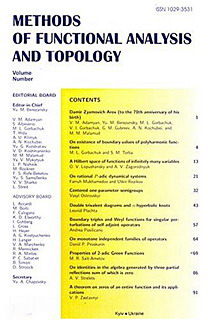Vol. 12 (2006), no. 1
The complex moment problem and direct and inverse spectral problems for the block Jacobi type bounded normal matrices
Yurij M. Berezansky, Mykola E. Dudkin
MFAT 12 (2006), no. 1, 1-31
1-31
We continue to generalize the connection between the classical power moment problem and the spectral theory of selfadjoint Jacobi matrices. In this article we propose an analog of the Jacobi matrix related to the complex moment problem and to a system of polynomials orthogonal with respect to some probability measure on the complex plane. Such a matrix has a block three-diagonal structure and gives rise to a normal operator acting on a space of l2 type. Using this connection we prove existence of a one-to-one correspondence between probability measures defined on the complex plane and block three-diagonal Jacobi type normal matrices. For simplicity, we investigate in this article only bounded normal operators. From the point of view of the complex moment problem, this restriction means that the measure in the moment representation (or the measure, connected with the orthonormal polynomials) has compact support.
Quantum of Banach algebras
MFAT 12 (2006), no. 1, 32-37
32-37
A variety of Banach algebras is a non-empty class of Banach algebras, for which there exists a family of laws such that its elements satisfy all of the laws. Each variety has a unique core (see [3]) which is generated by it. Each Banach algebra is not a core but, in this paper, we show that for each Banach algebra there exists a cardinal number (quantum of that Banach algebra) which shows the elevation of that Banach algebra for bearing a core. The class of all cores has interesting properties. Also, in this paper, we shall show that each core of a variety is generated by essential elements and each algebraic law of essential elements permeates to all of the elements of all of the Banach algebras belonging to that variety, which shows the existence of considerable structures in the cores.
Nevanlinna type families of linear relations and the dilation theorem
MFAT 12 (2006), no. 1, 38-56
38-56
Let H1 be a subspace in a Hilbert space H0 and let $\widetilde C(H_0,H_1)$ be the set of all closed linear relations from $H_0$ to $H_1$. We introduce a Nevanlinna type class $\widetilde R_+ (H_0,H_1)$ of holomorphic functions with values in $\widetilde C(H_0,H_1)$ and investigate its properties. In particular we prove the existence of a dilation for every function $\tau_+(\cdot)\in \widetilde R_+ (H_0,H_1)$. In what follows these results will be used for the derivation of the Krein type formula for generalized resolvents of a symmetric operator with arbitrary (not necessarily equal) deficiency indices.
Systems of $n$ subspaces and representations of $*$-algebras generated by projections
Yu. P. Moskaleva, Yu. S. Samoĭlenko
MFAT 12 (2006), no. 1, 57-73
57-73
In the present work a relationship between systems of n subspaces and representations of *-algebras generated by projections is investigated. It is proved that irreducible nonequivalent *-representations of *-algebras P4,com generate all nonisomorphic transitive quadruples of subspaces of a finite dimensional space.
Two-weighted inequality for parabolic sublinear operators in Lebesgue spaces
MFAT 12 (2006), no. 1, 74-81
74-81
In this paper, the author establishes the boundedness in weighted $L_p$ spaces on $\mathbb R^{n+1}$ with a parabolic metric for a large class of sublinear operators generated by parabolic Calderon-Zygmund kernels. The conditions of these theorems are satisfied by many important operators in analysis. Sufficient conditions on weighted functions $\omega$ and $\omega_1$ are given so that certain parabolic sublinear operator is bounded from the weighted Lebesgue spaces $L_{p,\omega}(\mathbb R^{n+1})$ into $L_{p,\omega_1}(\mathbb R^{n+1})$.
Lagrangian pairs in Hilbert spaces
MFAT 12 (2006), no. 1, 82-100
82-100
Weakly Lagrangian pairs and Lagrangian pairs in a pair of Hilbert spaces $(H_1, H_2)$ are defined. The weakly Lagrangian pair and Lagrangian pair extensions in $(H_1, H_2)$ of a given weakly Lagrangian pair in $(H_1, H_2)$ are characterized and those extensions which are operators are identified. A description of all Lagrangian pair extensions in a larger pair of Hilbert spaces $(\tilde H_1, \tilde H_2)$ of a given weakly Lagrangian pair in $(H_1, H_2)$ is also given.


